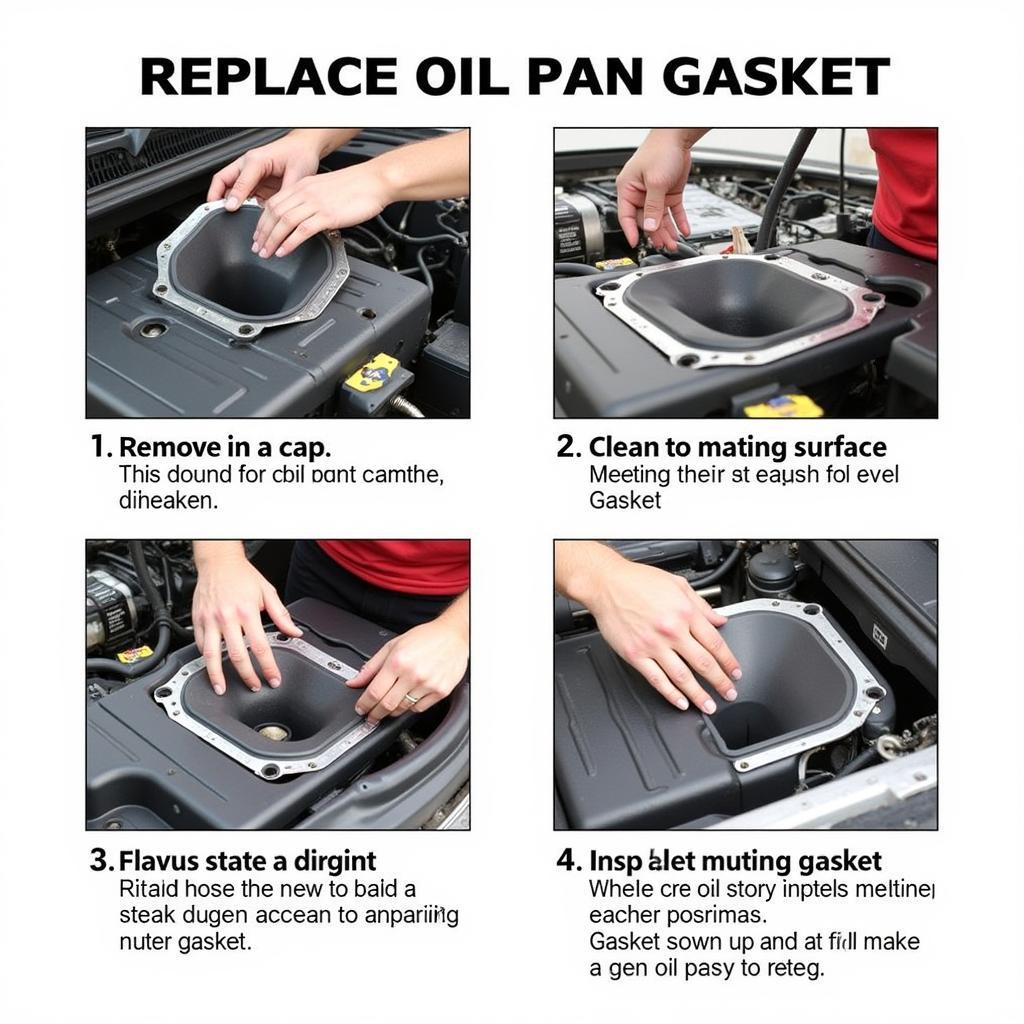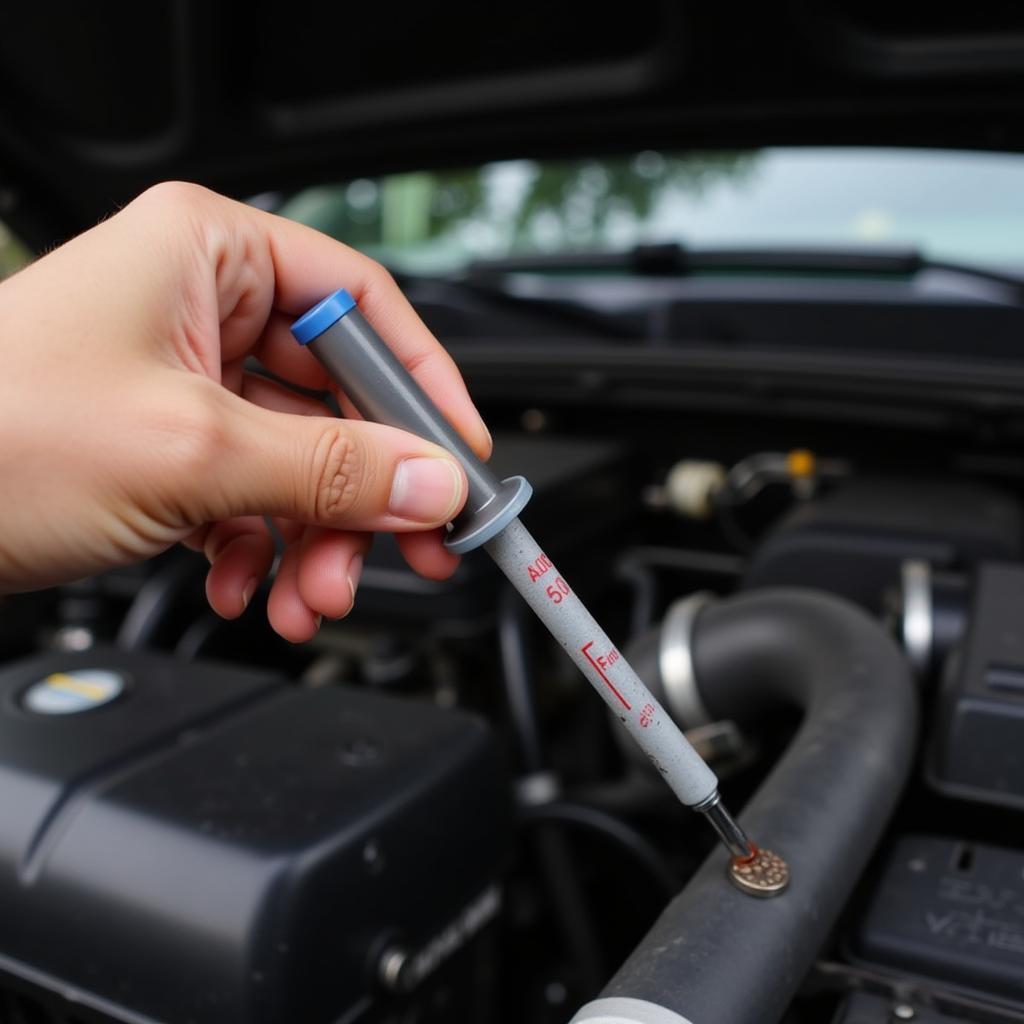Discovering an oil leak in your car can be alarming. But don’t panic! Knowing how to identify and address this issue can save you money and prevent further engine damage. This article will guide you through the process of diagnosing and potentially fixing an oil leak yourself.
Oil leaks are a common car problem, and understanding how to fix them can be incredibly helpful. Check out our resources on easy car problem fixes for more practical advice.
Identifying the Source of the Leak
Before you can fix an oil leak, you need to pinpoint its origin. Start by cleaning the area around the suspected leak with degreaser and then placing a clean piece of cardboard or paper underneath your car. This will help you collect dripping oil and better visualize the leak’s location. Common leak sources include the oil pan gasket, valve cover gasket, oil filter, and crankshaft seal.
Common Oil Leak Locations
- Oil Pan Gasket: This gasket seals the gap between the oil pan and the engine block. A damaged or deteriorated gasket can lead to significant oil loss.
- Valve Cover Gasket: This gasket seals the valve cover to the cylinder head. Leaks here are often less severe but can still create unpleasant odors and potential fire hazards.
- Oil Filter: An improperly installed or faulty oil filter can cause leaks.
- Crankshaft Seal: This seal prevents oil from leaking out where the crankshaft connects to the engine. Replacing this seal is more complex and often requires specialized tools.
How to Fix an Oil Leak: A Step-by-Step Guide
Once you’ve identified the source of the leak, you can determine if it’s a DIY fix or if you need professional help. Some leaks, like a loose oil filter, are simple to fix. Others, like a cracked oil pan, may require a mechanic’s expertise.
- Gather Your Supplies: You’ll need the correct replacement gasket or seal, wrenches, screwdrivers, degreaser, and a new oil filter (if necessary).
- Prepare the Area: Place your car on level ground and ensure it’s safely supported. Always disconnect the battery before working on any car repairs.
- Remove the Damaged Component: Carefully remove the component covering the leaking gasket or seal. This might involve removing bolts or other fasteners.
- Clean the Surfaces: Thoroughly clean the mating surfaces where the new gasket or seal will be placed.
- Install the New Gasket or Seal: Apply the new gasket or seal according to the manufacturer’s instructions. Ensure it’s properly seated and aligned.
- Reassemble the Components: Carefully reassemble all removed components, tightening bolts to the correct torque specifications.
- Refill Oil: Add the appropriate amount of oil to your engine. Check the dipstick to ensure the oil level is within the recommended range.
- Check for Leaks: Start the engine and let it run for a few minutes. Then, check for any signs of leaks.
 Replacing a Car’s Oil Pan Gasket
Replacing a Car’s Oil Pan Gasket
If you’re uncertain about any step, it’s best to consult a professional. Find an expert car fixing service to ensure the job is done right.
When to Seek Professional Help
While some oil leaks are simple DIY fixes, others require specialized tools and knowledge. If you’re uncomfortable working on your car’s engine, or if the leak seems complex, don’t hesitate to seek professional help. Ignoring a serious oil leak can lead to costly engine damage.
“A small oil leak might seem insignificant, but it can indicate a larger problem,” warns automotive expert, Michael Stevenson. “Addressing it promptly can prevent more serious issues down the road.”
Preventative Measures to Avoid Oil Leaks
Regular maintenance is key to preventing oil leaks. Regularly check your oil level and look for signs of leaks. Make sure your oil changes are performed according to the manufacturer’s recommendations. Using high-quality oil and filters can also help prevent leaks.
For reliable car repair, you might want to check out who can fix my car.com.
How Do I Fix an Oil Leak in My Car Without Draining the Oil?
Sometimes, you can address minor leaks without a full oil change. Tightening a loose oil filter or adding a stop-leak additive might be sufficient. However, if the leak is significant or persistent, draining the oil and replacing the faulty component is the best solution.
“Prevention is always better than cure,” says automotive specialist, Sarah Chen. “Regular maintenance can significantly reduce the risk of oil leaks and other car problems.”
Conclusion
Understanding how to fix an oil leak in your car can empower you to address this common issue. By following the steps outlined in this article, you can potentially save yourself time and money. Remember, if you’re unsure about any aspect of the repair process, it’s always best to consult a qualified mechanic. Don’t hesitate to contact AutoTipPro at +1 (641) 206-8880 or visit our office at 500 N St Mary’s St, San Antonio, TX 78205, United States for expert advice and assistance. Learn from others’ experiences, like Dani Jensen gets her car fixed, for added peace of mind. You might also find helpful tips on addressing overheating issues with our guide on fix car overheating.
FAQ
- What are the signs of an oil leak? Visible oil spots under your car, low oil levels, and a burning oil smell are common signs.
- How much does it cost to fix an oil leak? The cost varies depending on the source and severity of the leak. A simple oil filter replacement might cost under $50, while a major repair could cost hundreds.
- Can I drive my car with an oil leak? Driving with a significant oil leak can damage your engine. It’s best to address the leak promptly.
- What is the most common cause of an oil leak? Worn or damaged gaskets and seals are the most frequent culprits.
- How can I prevent oil leaks? Regular maintenance, including timely oil changes and using quality oil and filters, can help prevent leaks.
- What kind of oil should I use in my car? Consult your owner’s manual for the recommended oil type and viscosity.
- What is a stop-leak additive? A stop-leak additive is a product added to engine oil that can temporarily seal small leaks. It’s not a permanent solution.






Leave a Reply